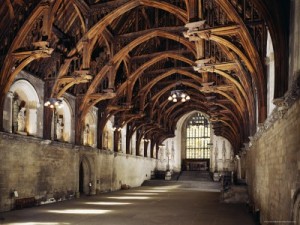With a history spanning more than 900 years, Westminster Hall is the only part of the ancient Palace of Westminster to survive in almost original form. Built between 1097 and 1099 by William Rufus it has played host to a variety of ceremonies and events. From great feasts and banquets to Tudor disguisings and even an early form of shopping centre!
Take a virtual tour of this extraordinary hall and explore the fantastic 3D reconstructed model of Westminster Hall in 1099 and 1400.
But most importantly, for fans of Anne Boleyn, it is where Anne’s lavish and magnificent coronation banquet was held in 1533. Over 80 dishes were served during the festivities and one can only imagine that Anne, six months pregnant, must have been exhausted but also overjoyed at having finally attained the ‘mystique of monarchy’ (Ives, 2004, p.179).
Edward Hall describes the hall in his account of Anne’s coronation:
And when the mass was done they left, every man in his order, to Westminster Hall, she still going under the canopy, crowned, with two sceptres in her hands, my Lord Wiltshire her father, and Lord Talbot leading her, and so dined there; and there was made the most honourable feast that has been seen.
The great hall at Westminster was richly hung with rich cloth of Arras, and a table was set at the upper end of the hall, going up twelve steps, where the queen dined; and a rich cloth of estate hung over her head. There were also four other tables along the hall; and it was railed on every side, from the high dais in Westminster Hall to the platform in the church in the abbey.
Upon leaving the hall Anne smiled and said ‘I thank you all for the honour ye have done to me on this day’ (Ives, 2004, p, 181).
Westminster Hall was also the setting of Thomas More’s trial where he was charged of High Treason for denying the validity of the Act of Succession.
Westminster Hall is most definitely another worthy stop on the Tudor Trail.
Sources
Westminster Hall Official Website
Ives, E. (2004). The Life and Death of Anne Boleyn. Blackwell Publishing.





















Leave a Comment